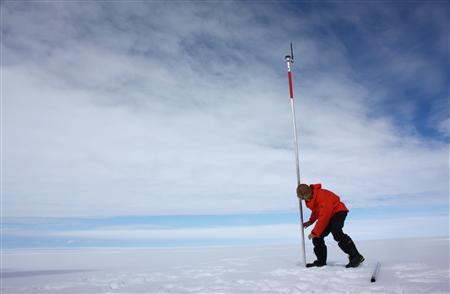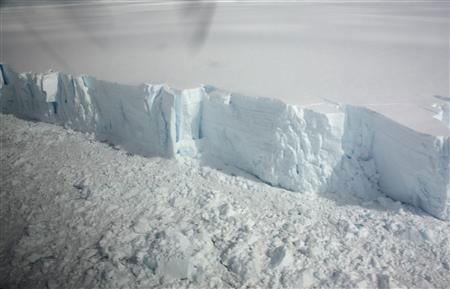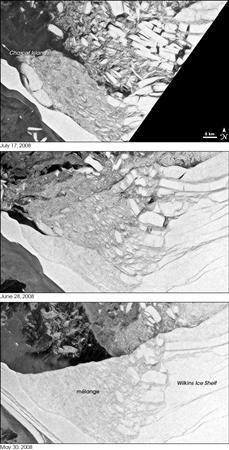|

by Alister Doyle
Environment Correspondent Reuters
January 20, 2009
from
Reuters Website
WILKINS ICE SHELF, Antarctica (Reuters)
-

David Vaughan, a
glaciologist with the British Antarctic Survey,
installs a pole as
part of a satellite monitoring system into the Wilkins Ice Shelf off
the Antarctic Peninsula on January 18, 2009.
A huge Antarctic ice shelf is on the
brink of collapse with just a sliver of ice holding it in place, the
latest victim of
global warming
that is altering maps
of the frozen continent.
"We've come to the Wilkins Ice Shelf
to see its final death throes," David Vaughan, a glaciologist at
the British Antarctic Survey (BAS), told Reuters after the first
- and probably last - plane landed near the narrowest part of
the ice.
The flat-topped shelf has an area of
thousands of square kilometers, jutting 20 meters (65 ft) out of the
sea off the Antarctic Peninsula.
But it is held together only by an ever-thinning 40-km (25-mile)
strip of ice that has eroded to an hour-glass shape just 500 meters
wide at its narrowest.

A 20 meter-high ice
cliff forming the edge of the Wilkins Ice shelf on the Antarctic
Peninsula is seen from a plane January 18, 2009.
The huge Antarctic
ice shelf is on the brink of collapse with just a sliver of ice
holding it in place,
the latest victim of
global warming
that is altering maps of the frozen continent.
In 1950, the strip was almost 100 km
wide.
"It really could go at any minute,"
Vaughan said on slushy snow in bright sunshine beside a red Twin
Otter plane that landed on skis.
He added that the ice bridge could
linger weeks or months.
The Wilkins once covered 16,000 sq km (6,000 sq miles). It has lost
a third of its area but is still about the size of Jamaica or the
U.S. state of Connecticut. Once the strip breaks up, the sea is
likely to sweep away much of the remaining ice.
Icebergs the shape and size of shopping malls already dot the sea
around the shelf as it disintegrates. Seals bask in the southern
hemisphere summer sunshine on icebergs by expanses of open water.
A year ago, BAS said the Wilkins was "hanging by a thread"
after an aerial survey.
"Miraculously we've come back a
summer later and it's still here. If it was hanging by a thread
last year, it's hanging by a filament this year," Vaughan said.

Antarctica's Wilkins
Ice Shelf is seen disintegrating in a series of images taken from
May 2008 (bottom) to July 2008 (top).
A huge Antarctic ice
shelf is on the brink of collapse with just a sliver of ice holding
it in place,
the latest victim of
global warming
that is altering maps of the frozen continent.
Nine
other shelves have receded or collapsed around the
Antarctic peninsula in the past 50 years, often abruptly like the
Larsen A in 1995 or the Larsen B in 2002.
The trend is widely blamed on climate
change caused by heat-trapping gases from burning fossil fuels.
WARMING TO
BLAME
"This ice shelf and the nine other
shelves that we have seen with a similar trajectory are a
consequence of warming," Vaughan said.
In total, about 25,000 sq/km of ice
shelves have been lost, changing maps of Antarctica. Ocean sediments
indicate that some shelves had been in place for at least 10,000
years.
Vaughan stuck a GPS monitoring station on a long metal pole
into the Wilkins ice on behalf of Dutch scientists. It will track
ice movements via satellite.
The shelf is named after Australian George Hubert Wilkins, an early
Antarctic aviator who is set to join an exclusive club of people who
have a part of the globe named after them that later vanishes.
Loss of ice shelves does not raise sea levels significantly because
the ice is floating and already mostly submerged by the ocean. But
the big worry is that their loss will allow ice sheets on land to
move faster, adding extra water to the seas.
Wilkins has almost no pent-up glaciers behind it. But ice shelves
further south hold back vast volumes of ice.
"When those are removed the glaciers
will flow faster," Vaughan said.
Temperatures on the Antarctic Peninsula
have warmed by about 3 Celsius (5.4 Fahrenheit) since 1950, the
fastest rise in the southern hemisphere. There is little sign of
warming elsewhere in Antarctica.
BAS scientists and two Reuters reporters stayed about an hour on the
shelf at a point about 2 km wide.
"It's very unlikely that our
presence here is enough to initiate any cracks," Vaughan said.
"But it is likely to happen fairly soon, weeks to months, and I
don't want to be here when it does."
The U.N. Climate Panel, of which
Vaughan is a senior member, projected in 2007 that world sea levels
were likely to rise by between 18 and 59 cm (7 and 23 inches) this
century.
But it did not factor in any possible acceleration of ice loss from
Antarctica. Even a small change in the rate could affect sea levels,
and Antarctica's ice sheets contain enough water in total to raise
world sea levels by 57 meters.
About 190 nations have agreed to work out a new U.N. treaty by the
end of 2009 to slow global warming, reining in emissions from
burning fossil fuels in power plants, cars and factories.
FACTBOX
editing by Andrew Roche
The Antarctic Peninsula's vast Wilkins Ice Shelf is poised to
become the 10th floating shelf on the frozen continent to
recede or vanish into the ocean.
A Reuters visit to the Wilkins with the British Antarctic
Survey, making the first plane landing in the area, showed it was
held in place only by a 40 km (25-mile) long strip of ice that has
shrunk to about 500 meters (1,600 ft) wide at its narrowest point
and could collapse at any time.
Fifty years ago, the strip was more than 100 km wide. The shelf
is still about the size of Jamaica.
Following are facts about ice shelves.
-
Ice shelves are extensions of
land-based ice sheets that float on the sea. They can be
several hundred meters thick and are found mainly in bays
around Antarctica, with some in the Arctic. Antarctica's
biggest, the Ross Ice Shelf, is the size of France.
-
Scientists worry that that the
collapse of ice shelves could prompt glaciers inland to
start sliding faster toward the sea, raising sea levels.
Antarctica holds enough fresh water to raise sea levels by
57 meters (187 ft), so even a limited melt would have big
consequences.
-
Since 1950, ten ice shelves on
the Peninsula, which snakes up toward South America, have
contracted or collapsed.
-
The British Antarctic Survey
reckons that 25,000 sq km (10,000 sq mile) of ice shelves
have been lost in total - an area the size of Macedonia,
Rwanda or the U.S. state of Vermont.
-
Ice shelves that have broken up
since 1950 are the Larsen A, Larsen B and Larsen C, Prince
Gustav, Muller, Jones, Wordie, George VI north, George VI
south and the Wilkins.
-
Among the most dramatic
collapses was that of the Larsen A within a few weeks in
1995, when satellite images abruptly showed the bay dotted
with icebergs. The Larsen B also abruptly collapsed in 2002.
|



